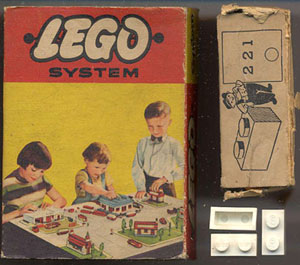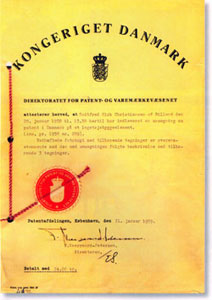 On January 28, 1958 at 1:58 pm Godtfred Kirk Christiansen submitted the patent application for the improved Lego brick and building system in Copenhagen, Denmark. Today, the thousands of different shapes, sizes and colors of Legos are all designed to connect with the original brick from the Danish patent. All 2×4 Legos made since 1958 have been manufactured to the exact same measurements as the version outlined in the original patent.
On January 28, 1958 at 1:58 pm Godtfred Kirk Christiansen submitted the patent application for the improved Lego brick and building system in Copenhagen, Denmark. Today, the thousands of different shapes, sizes and colors of Legos are all designed to connect with the original brick from the Danish patent. All 2×4 Legos made since 1958 have been manufactured to the exact same measurements as the version outlined in the original patent.
Legos began in the workshop of a carpenter from Billund, Denmark. Ole Kirk Christiansen was a carpenter who made his living building houses and furniture for farmers. A fire in his workshop and the Great Depression ultimately led Christiansen to begin producing wooden toys including piggy banks, cars and trucks in 1932. The name Lego was given to the business in 1934. The word is a self-made contraction of the Danish words leg and godt which mean play well. Det beste er ikke for godt which roughly translates to mean “Not even the best is good enough” was the Lego motto.
In 1947, the Lego Company purchased Demark’s first plastic injection-molding machine for making toys. The first big plastic toy hit for the Lego company was a model tractor produced as a Christmas toy in 1951. In 1949, the Christiansens introduced “Automatic Binding Bricks.” These first plastic building blocks had pegs on top and hollow bottoms. They allowed children to build structures never even dreamed of with wooden blocks but these bricks still had problems with stability. The hollow bottoms meant the bricks never really stuck together. These new bricks despite being a great improvement over wooden bricks were not well received. Sales of these toys were very limited in the early 1950’s.
 Godtfred Christian, son of Ole Kirk, saw the immense potential of these bricks as a play system for children. After extensive experimentation, Godtfred Christian settled on the stud and tube solution to improve the stability of the bricks. In 1958, the “Lego System of Play” consisting of 28 sets and 8 vehicles was introduced. Legos were first introduced to the United States in 1961. The same year, Godtfred Christian was issued his first US Patent. On October 24, 1961, patent #3,005,282 was issued for toy building bricks. In 1962, the Lego company switched from using Cellulose Acetate to Acrylonitrile Butadeine Stryrene to manufacture the play bricks. This new material was more colorfast and durable.
Godtfred Christian, son of Ole Kirk, saw the immense potential of these bricks as a play system for children. After extensive experimentation, Godtfred Christian settled on the stud and tube solution to improve the stability of the bricks. In 1958, the “Lego System of Play” consisting of 28 sets and 8 vehicles was introduced. Legos were first introduced to the United States in 1961. The same year, Godtfred Christian was issued his first US Patent. On October 24, 1961, patent #3,005,282 was issued for toy building bricks. In 1962, the Lego company switched from using Cellulose Acetate to Acrylonitrile Butadeine Stryrene to manufacture the play bricks. This new material was more colorfast and durable.
Today, Legos are a very popular toy for both children and adults all over the world. Nineteen billion legos are produced every year. Seven Lego sets are sold every second around the world. More than 400 billion Legos have been produced since 1949. That is 62 Legos for each person in the world. More than 400 million people in the world have played with Legos.
